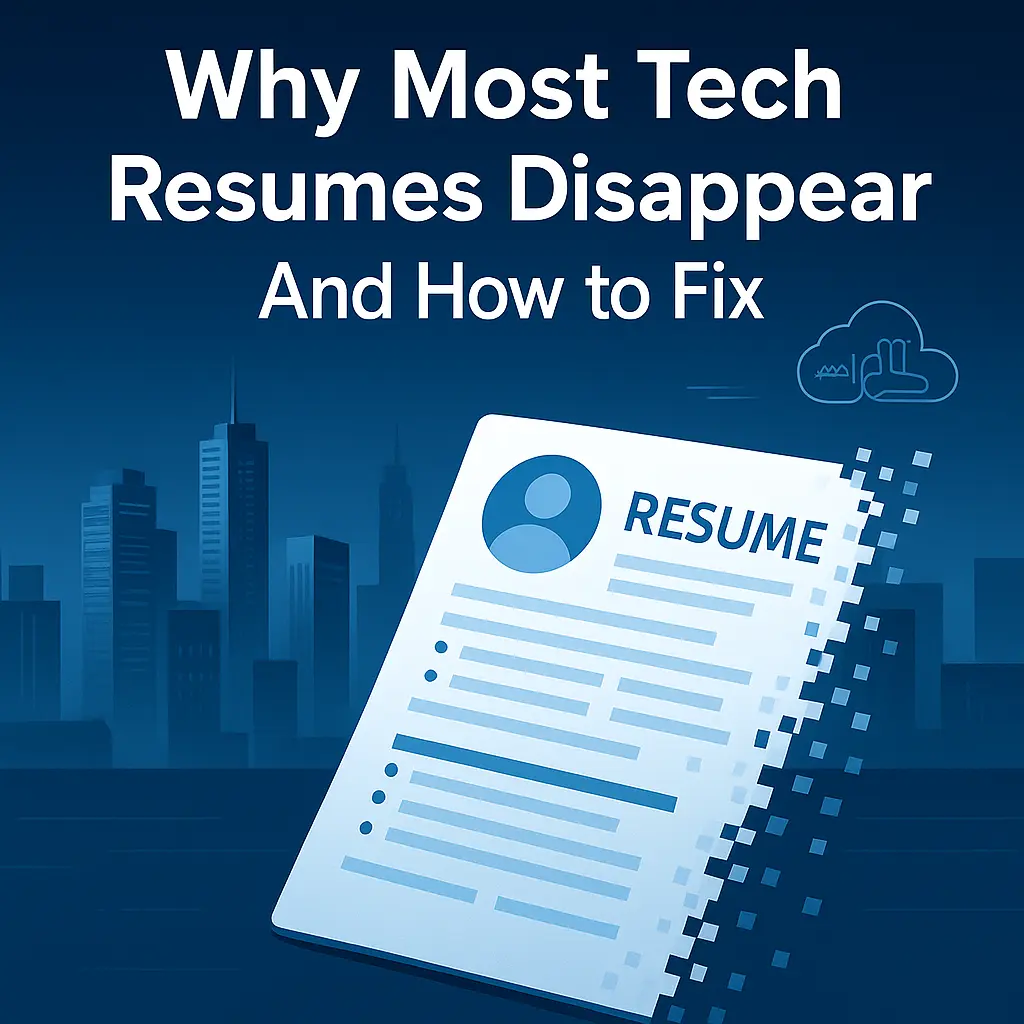Many job seekers feel lost when writing their resumes, and it's understandable.
You may look at someone else's resume and think you should copy it, especially if they landed a great position. This is a common mistake in the job application process.
This is what you need to understand.
One person's resume format or content will not always work for another. People have different career paths, skills, and experiences that do not fit into one cookie-cutter template.
This guide will show why each resume needs to reflect your personal branding and highlights. You will learn how to use tools like Jobsolv to craft a strong document. Your next step could change how employers see you
Why Every Resume is Unique
No two people take the same career path or learn in exactly the same way.
That’s why your resume should reflect what makes you unique. Maybe you’re a software engineer building apps, a graphic designer creating brand logos, or a data analyst digging into complex data.
Each field has its own hiring style.
What works in tech might not make sense in design or research. Your resume should match the industry you're aiming for.
For example, one applicant had more than ten years of experience before earning a degree. They chose to list their work history before their education, and it worked well. In some fields, hands-on experience speaks louder than a diploma.
Your career stage matters too.
A professional in their fifties once summed up fifteen years of early experience in one sentence. That choice wasn’t about skipping the past. It was about keeping the spotlight on the most relevant and recent roles.
Different industries have different expectations. A visually creative resume might grab attention at a design agency but feel out of place in a technical or academic setting. What impresses one hiring manager might confuse another.
In the end, your resume should tell your story clearly and confidently. The way you highlight your skills, choose your words, and reference your LinkedIn or portfolio projects should feel intentional.
Everything on the page should reflect who you are and where you're headed.
📌 The longer you use the wrong resume, the more interviews you’ll keep missing. Fix your resume and land more interviews.
Varying Skill Sets and Experiences
- Your resume should reflect how you apply your skills.
For example, a UX designer with a psychology background might highlight user behavior testing and A/B research instead of just listing wireframing or prototyping. - Multipotentialites like those with hybrid roles, often referred to as generalists or polymaths. These are individuals with multiple career interests or paths. They tend to succeed by customizing their resumes based on the role they’re targeting, clearly highlighting which career direction or niche they’re focused on.
One simple advice is, you have to build a base resume, then tailor by focusing on transferable outcomes that matter to the role and not just responsibilities.
For example: You’re applying for both product management and analytics roles. Here are two versions of your resume.
- The product management resume emphasized cross-functional team leadership, backlog grooming, and sprint planning.
- The analytics version spotlighted SQL dashboards, experimentation design, and customer segmentation models.
- Tell a cohesive story. If you're in a field like education or nonprofit, resumes that tell a cohesive story across varied roles tend to perform better.
For example, one education consultant highlighted how curriculum design and fundraising both tied into strategic impact, not just job diversity. - Using a “value-first resume” format, where each bullet starts with the outcome, not the task. This is especially effective for applicants with nonlinear paths or gaps in their resume.
- Keep multiple resumes, but don’t just swap job titles. Adjust keywords, metrics, and framing. This is especially important for roles in marketing, business analysis, or HR, where the same job title can mean different things depending on the company size and industry.
Industry-specific requirements
Not every industry looks at your resume the same way.
What gets a callback in tech might be a red flag in healthcare, and what excites a startup founder might feel irrelevant to a corporate recruiter.
Startups, for example, want to see proof that you’ve been in the trenches. Forget surface level stuff.
They’re not impressed by generic buzzwords pulled from a job post. What they want is real evidence that you’ve solved problems like the ones they’re facing now. A hiring manager at a SaaS startup once said,
“If I see another resume with ‘strategic thinker’ and no example, I’m out.”
So instead of saying you're adaptable, talk about how you stepped into a chaotic project mid-launch and turned it around in two weeks.
It’s the same in tech.
Your resume should speak the language of tech engineers and product teams. Listing Python or SQL is one thing, but showing how you used it is what makes you stand out.
Did you cut report generation time in half by automating processes? Did your code help scale an app to support twice the number of users? That’s what they’re looking for: clear, measurable outcomes tied to the tools you claim to know.
Healthcare, on the other hand, is much more credential-driven.
Recruiters need to see your licenses, certifications, and clinical experience up front. But that doesn’t mean it should read like a list of duties. Use specifics. Instead of saying “provided patient care,” say something like “cared for 15+ patients per shift in a high-pressure trauma unit while maintaining 100% accuracy in charting.”
These details paint a picture of what you can handle in real time.
And here’s the part many job seekers overlook. Job descriptions are your best friend. They’re not just there to inform you.
They give you a roadmap for what matters most to that employer. Pay attention to repeated keywords and expectations. If a posting mentions “cross-functional collaboration” three times, that’s a signal.
But don’t just repeat the phrase. Show how you led a project between product, sales, and engineering and what the outcome was.
Generic resumes are easy to spot.
Recruiters see hundreds every week. But when your resume speaks directly to their pain points, backed by real results, you move to the top of the pile.
You’re not just another applicant. You’re someone who gets it.
📌 A tailored resume is the secret to getting hired. Use this free resume customization tool. No hassle, No commitment.
Avoid Copying Resumes
Using someone else’s resume as a template is fine, but copying it line by line is where things go wrong.
Recruiters can spot recycled language a mile away. Even worse, it often works against you. Your resume should reflect who you are, not sound like every other applicant using the same generic format or template.
Imagine the stress if you were the recruiter flooded with those generic applications.
Here’s what to keep in mind:
- Recruiters recognize overused phrases. Words like “team player,” “hardworking,” or “results-oriented” show up so often that they’ve lost meaning, especially when there’s no context to support them.
- Your resume isn’t a fill-in-the-blank worksheet. Just because a certain format worked for someone else doesn’t mean it reflects your unique experience or fits the role you're applying for.
- Copied resumes usually miss the mark. They tend to ignore the specific needs of the job or industry, which means you're not speaking to what the hiring manager actually wants.
- You lose your voice. When you borrow someone else's words, you strip away the personality and clarity that make your background stand out.
- Hiring managers review hundreds of resumes. If yours reads like a copy-paste job or sounds like it came straight from an AI tool, it likely won’t get a second look.
Instead:
- Use samples only for structure or layout ideas, not for the actual content.
- Highlight your real contributions using numbers, tools, or achievements that are unique to your experience.
- Speak in your own voice. Clear, direct language always beats cliches.
How to Tailor a Resume That Works for You
The truth is, no two job applications should ever have the exact same resume.
Hiring managers aren’t just looking for a qualified candidate. They’re scanning for signals that you understand their specific needs and can hit the ground running. That means tailoring isn’t optional.
Start with the job description.
Read it the way a hiring manager would. What’s their pain point?
What are they really hoping this person can solve? Take those insights and shape your resume around them.
If they’re looking for someone who can lead cross-functional teams, show evidence of how you’ve done that. If the posting emphasizes technical expertise, don’t bury your skills under generic summaries.
Bring them forward, tie them to outcomes, and name the tools you actually used.
Tailoring also means editing ruthlessly.
You may have achievements you’re proud of, but if they’re not relevant to this specific role, they can distract more than help. Every line on your resume should serve a purpose.
It should show the hiring team why you're a match, not just in title but in capability.
But What If You’re Not Sure How to Do That?
Resume writing in itself is exhausting.
This process takes effort, and it’s where many job seekers get stuck. You know your experience, but turning it into a clear, concise, role-specific resume every time is not easy.
This is where a resume customization tool becomes your friend. Not because it writes the resume for you, but because it helps you write better.
The misconception about resume customization tools is that they do the job for you.
This leads to confusion, complacency, and dependency, which often turns into frustration. The promise of getting hired simply by using a tool sounds too good to be true, and it usually is. Relying on it completely can actually hurt your chances of landing the job.
These tools analyze the job posting, pull out key skills and keywords, and highlight where your current resume might be falling short. You get structured suggestions on how to rewrite your bullet points to mirror what the employer wants, without losing your authentic voice.
You also save time.
Instead of starting from scratch or rewording blindly, a good customization tool shows what matters most in a particular role. It prompts you to tailor, not just tweak your resume so that it gets noticed by both ATS filters and human reviewers.
At the end of the day, tailoring your resume is about showing intentionality. A resume that reflects the needs of the job tells hiring managers one thing: you understand their world, and you're ready to contribute.
📌 Recruiters can tell when you’re playing the copy-paste game. Stop it if you don’t want to be auto-rejected. Customize your resume here or look for remote jobs. You can do both.
FAQs About Your Resume
Q: Why shouldn’t I copy a resume that worked for someone else?
Because resumes are context-driven. What landed someone a job at a design agency might not work in another field. Their strengths, goals, and background may be different from yours. A copied resume doesn’t tell your story, and hiring managers can usually tell when something feels generic or borrowed.
Q: Is it okay to use templates?
Yes, but only for layout and organization. A template can provide a starting point for formatting, but the content must be original and tailored to your experience. Avoid copying summaries or bullet points that don’t reflect your actual background. In general, it’s best to avoid templates altogether because they're often difficult to customize and frequently get rejected due to unnecessary designs, fonts, and images that are not compatible with ATS systems.
Q: What’s the biggest mistake people make when customizing their resume?
They focus only on inserting keywords. Tailoring a resume is not just about mirroring the job description. It's about showing real, relevant experience that proves you can deliver value in that specific role and work environment.
Q: How do I know what to emphasize in my resume?
Look closely at the job posting and highlight recurring themes or skills. If collaboration, data analysis, or leadership is mentioned more than once, those are priorities. Choose your most relevant experiences and explain how you’ve demonstrated those strengths.
Q: What if my experience doesn’t match the job perfectly?
That’s more common than people realize. Focus on transferable skills like problem-solving, communication, or time management. Show how these apply in the context of the new role, using examples that prove your adaptability.
Q: Should I have more than one version of my resume?
Yes, especially if you’re targeting different roles or industries. Each version should prioritize the experience, tools, and accomplishments that best align with the type of job you're applying for.
Q: What do hiring managers look for beyond skills?
They look for alignment with the company and role. This includes how clearly your resume is written, whether your achievements are relevant, and if your personality or values seem like a good fit for their culture.
Q: Are resume customization tools worth using?
They can be useful if used the right way. A great tool like Jobsolv will help you identify gaps, suggest improvements, and guide you in aligning your resume with the job. But it won’t replace the need to think strategically and write authentically.
Q: Can a one-size-fits-all resume still work in 2025?
Unlikely. With the volume of applicants most roles receive, a generic resume often gets ignored. Tailoring your resume shows effort, strategy, and attention to detail, which are all things employers appreciate.
Q: How can I make my resume feel more like “me”?
Write clearly and honestly. Focus on what you’ve actually done and speak in a tone that feels natural to you. Avoid cliches and focus on real outcomes. The more grounded and specific your resume is, the more authentic and memorable it will be.
Final Thoughts: Your Resume Should Work For You
What resume works for them doesn't mean it works for you.
That’s the truth many job seekers overlook. Borrowing someone else's format, tone, or list of achievements might feel like a shortcut, but it usually leads to rejection. Recruiters can quickly tell when a resume lacks originality, and more importantly, it fails to reflect who you are as a candidate.
The most effective resumes are not one-size-fits-all.
They are tailored to match the specific job, written in your own voice, and built around your real contributions. That kind of clarity and relevance can't be copied. It has to come from you.
If your job search has hit a wall, take a closer look at what you're submitting.
Is your resume aligned with what the hiring manager is asking for, or is it a version of someone else's success story? Tools like Jobsolv can help guide you, especially when you're stuck on structure or keywords, but it's your insight and experience that need to lead the way.
Because in a competitive job market, the goal isn't to blend in with what worked for someone else. It's to stand out with what truly works for you.
📌 Stop copy-pasting resumes that aren’t yours. Build one that finally works.
.svg)


















